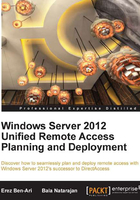
Hello Unified Remote Access!
Customer support can be funny, but remote access is serious business. Ever since the Internet came into our homes several decades ago, people have been using various solutions and technologies to connect to the corporate network, and work remotely. Many technologies came our way over the years; analog modem dialup initially, then ISDN, and most recently DSL, Cable, LTE, and WiMAX. Whatever connection type your users are using, virtually all solutions involve one thing in common: when the user needs to connect, he has to launch some kind of program to establish that connection. This inherent design has always been a burden, as users find various ways to mess up the connection (and let's face it...sometimes...rarely...it's not even their fault).
A few years ago, Microsoft came up with the concept that became known as DirectAccess, and integrated it into Windows Server 2008 R2. The big deal was that finally, the connection configuration was configured automatically via Group Policy, so the IT department didn't have to set up each computer separately. Secondly, the DirectAccess (often referred to unofficially as DA) connection was designed to automatically establish itself as soon as the computer leaves the corporate network and connect to the public Internet. With DirectAccess, the entire thing was as seamless as a cellular service. The user goes home, opens his laptop and he is virtually on the corporate network. No software to configure and re-configure, and no buttons to push.
Initially, DirectAccess was easy for users, but not so much for us administrators. To set up DirectAccess, you would have to configure many complex settings in Group Policy and a lot of good and smart administrators found themselves giving up on it after weeks of fiddling. Then, in January 2010 Microsoft came out with Forefront Unified Access Gateway (UAG).
UAG, which is Microsoft's enterprise-class application publishing and remote access server, includes a special interface designed to allow the configuration and deployment of DirectAccess in a way that's a lot friendlier than before, such as support for IPv4-only networks via NAT64 and DNS64, and support for array-deployment. The product was a tremendous success, and was adopted by some of the largest companies in the world, as well as governments and military organizations. The following is a screenshot of the UAG console:

This great success led to a decision to enhance DirectAccess, and with the release of Windows Server 2012, a new interface was built, that no longer required UAG to be in the picture. The technology was also renamed to Unified Remote Access, and with Windows Server 2012, you could configure it straight out of the box as a role, without purchasing or installing any additional software. In addition, several aspects of it have been simplified, making it even more approachable and usable than before.